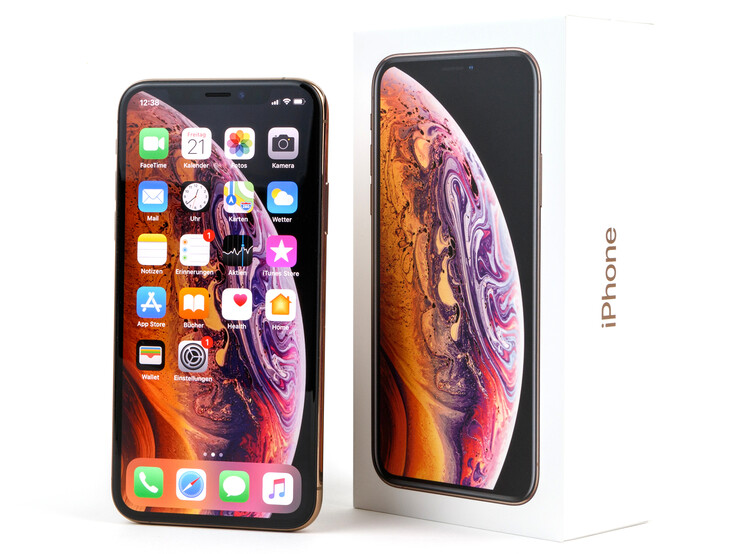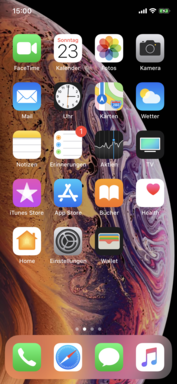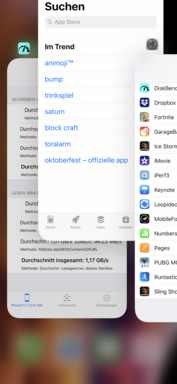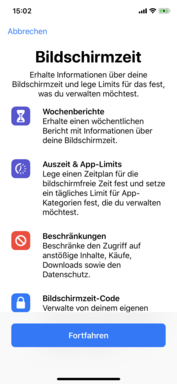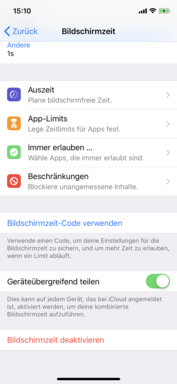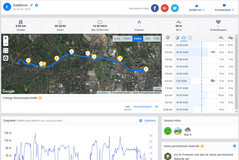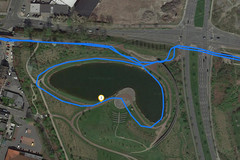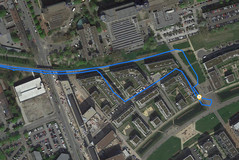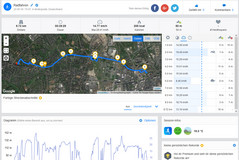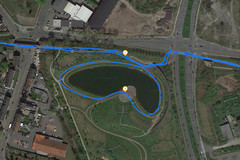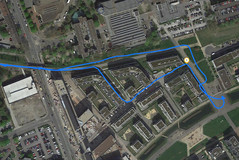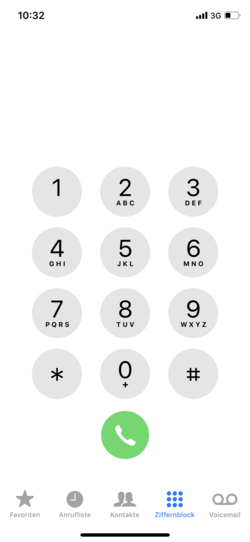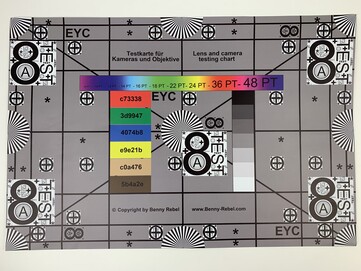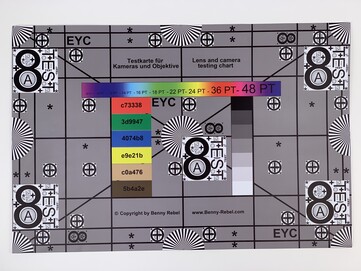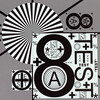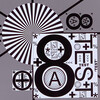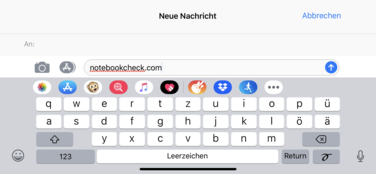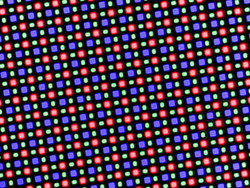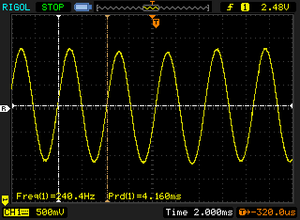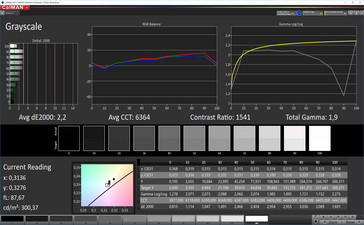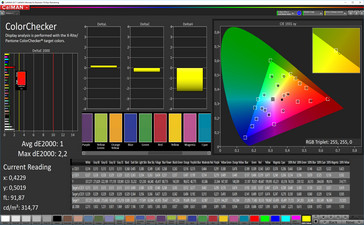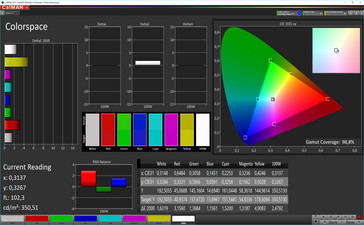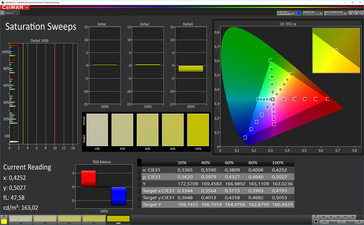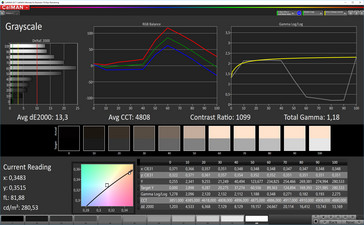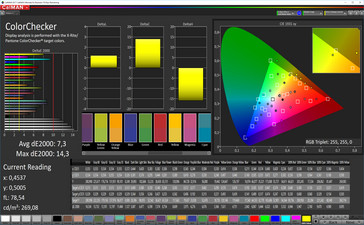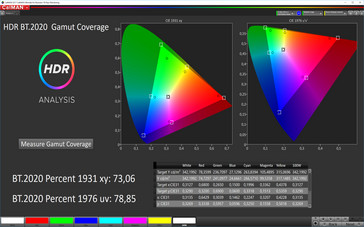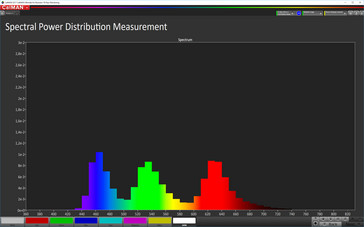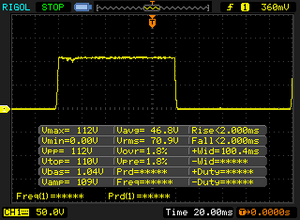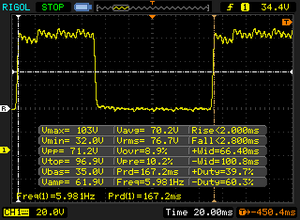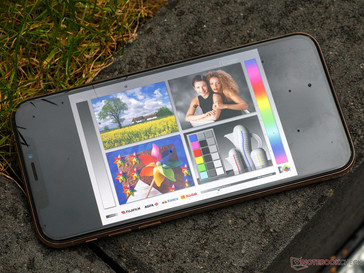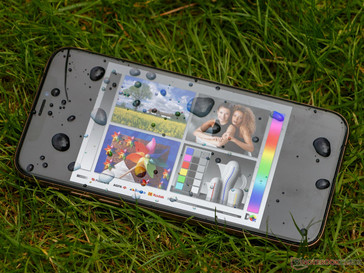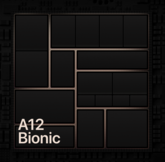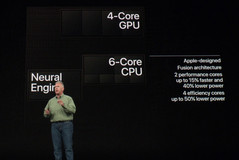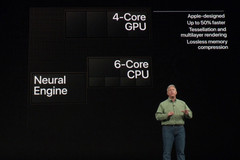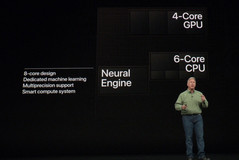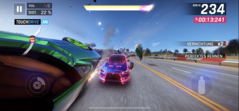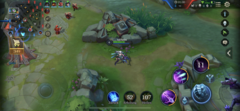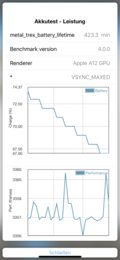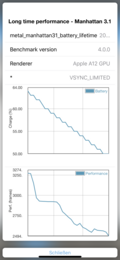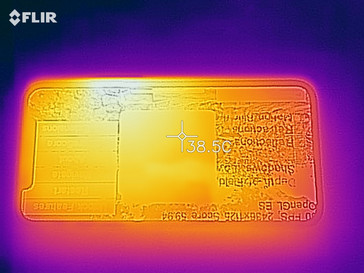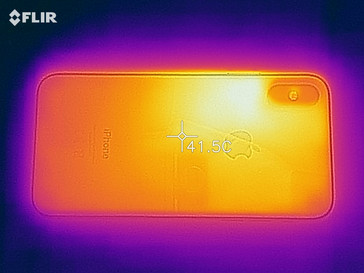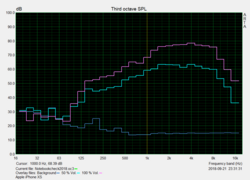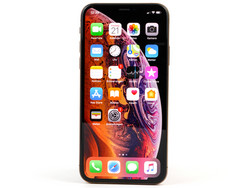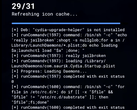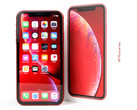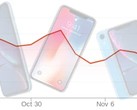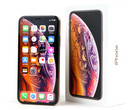Apple iPhone XS Smartphone Review
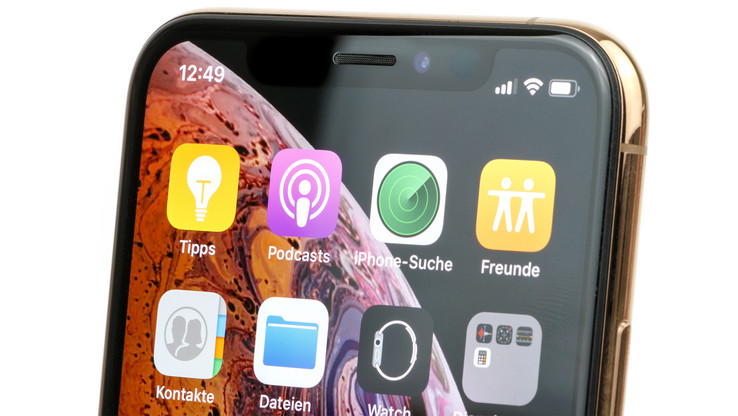
Every year a new iPhone comes fluttering into Apple Stores at the beginning of fall. This remains the same this year too. In this review, we are focusing on the smaller of Apple’s new flagship devices, the iPhone XS. Apple still insists that the device is pronounced the iPhone 10S and not XS. Powering the device is Apple’s new A12 Bionic chipset and 4 GB RAM, the latter of which is a considerable jump in RAM and one which Apple has previously reserved just for its iPad Pro devices. The iPhone XS retains the iPhone X’s 5.8-inch display, but Apple should have improved things like the maximum luminosity and color accuracy.
The device comes with a new camera sensor too, which has larger pixels for improved photosensitivity than its predecessor. The iPhone XS also comes with up to 512 GB of storage and even dual-SIM support. A word of caution on this, practically all iPhone XS devices are equipped with one physical nano-SIM slot and an eSIM slot. Few carriers currently support eSIMs though, the limitations of which are reflected by Apple releasing a version of the iPhone XS with two nano-SIM slots for the Chinese market. Apple has also improved the XS’ IP rating over its predecessor too.
Apple’s pricing for the iPhone XS is breathtakingly high. The entry model with 64 GB of storage costs 1,149 Euros (~$1,347) at launch, while the 256 GB and 512 GB models cost 1,319 Euros (~$1,547) and 1,549 Euros (~$1,817), respectively. The iPhone XS Max costs an additional 100 Euros (~$117) across all three models. What’s more, Apple has replaced both the iPhone 8 and X series with the 10S series, effectively increasing the cost of an Apple flagship device by 350 Euros (~$410).
We have chosen to compare the iPhone XS against its predecessor and other Android flagship devices like the Google Pixel 2 XL, HTC U12+, Huawei P20 Pro, LG G7 ThinQ, OnePlus 6, Samsung Galaxy S9 and the Sony Xperia XZ2 Premium.
Changelog
Update: First impressions, display measurements (PWM), Wi-Fi performance and initial benchmarks.
Update II: Further benchmarks, battery tests and sections on Communication, Accessories, Connectivity and Speakers have been added.
Update III: Sections added for GPS, Display and Cameras.
Update IV: Sections added for Software, Input Devices, Performance, Temperature and further Battery tests.
Case
The iPhone XS looks broadly the same as its predecessor save for a new color option. The XS comes in black, white or a new gold finish, the latter of which offers reflections in a pearlescent fashion depending on the viewing angle. The XS shares the same dimensions as its predecessor but is 3 g heavier according to Apple; we could not confirm this during our tests. Contrary to Apple’s documentation, our test device is slightly thinner than its predecessor at 7.65 mm. Additionally, Apple has thickened the camera array, which now protrudes by 1.5 mm from the rear case.
The XS has a stainless-steel frame while the front and back of the device are made from the same unspecified glass. Apple insists that this glass is the most durable of its kind; naturally, we would expect nothing less from Apple.
The XS has excellent build quality with tight and even gaps between materials across the entire device. Moreover, the XS is stiff as a board and made no cracking noises during our best attempts to twist our test device. Our test devices feel good in the hand too and not particularly heavy. However, it is worth pointing out that the gold version is vulnerable to fingerprints. Additionally, while the glass is relatively easy to clean, cleaning the stainless-steel frame requires a lot more effort.
The iPhone XS is dust and water-resistant like its predecessor, but Apple has increased the IP rating to IP68, which should mean that the device can survive up to 30 minutes submerged in water. However, strictly speaking, the rating is IPX8 and not IP68, as Apple does not provide a time limit for submerging the device. The XS is also beer, chlorine, salt water, tea and even wine resistant according to Apple’s keynote. Pleasingly, liquid damage does not invalidate a warranty claim.
The SIM slot continues to only accept one nano-SIM, except for in China where Apple is releasing a true dual-SIM variant. The rest of the world gets dual-SIM functionality from an eSIM rather than a traditional nano-SIM.
Connectivity
The Lightning port remains the only way to connect the XS to a computer or an accessory with a wired connection. Officially the device supports USB 3.0, but Apple has only included a USB 2.0 cable in the box as evidenced by the length of time it took to complete a large data transfer on iTunes. You will need to buy a Lightning cable to USB-C if you want faster data transfer. Apple also offers numerous Lightning adapters to Thunderbolt, card readers, and video connections like HDMI.
The XS retains the same short-range wireless communication that the iPhone X supported. The XS also supports Bluetooth 5.0 and NFC, the latter of which is restricted just to read mode.
The sensors remain the same too. Face ID is still the only biometric security method, and no new iPhones have Touch ID support.
The eSIM function is not yet active and will be activated in a forthcoming update.
Software
A new iPhone release is always synonymous with a new version of iOS. The iPhone XS runs iOS 12, which contains numerous changes from previous iterations. Apple stresses that iOS 12 is much faster than previous versions and should run faster on older devices. Apple is so sure of this that it is pushing iOS 12 out to even five-year-old devices like the iPhone 5S and the iPad Air. Other manufacturers should take note as few of Apple’s competitors currently support their devices for as long as Apple.
iOS 12 brings new features to FaceTime including calls with up to 32 simultaneous participants. Likewise, iMessage has new text effects, emojis, Animojis, and Memojis, the latter of which allows users to create Animojis of their faces. Notifications and the Do Not Disturb feature have been enhanced and further optimized too. Moreover, iOS 12 brings new Siri features and allows the virtual assistant to learn things like routines that are triggered by voice commands among others. Face ID can now also unlock the device with up to two scanned faces.
A completely new feature is the screen time option. The feature serves to better control the device’s usage behavior on the one hand and act as a way for parents to limit children’s time on Apple devices on the other hand, like Google’s FamilyLink. The Apple app is better thought out though particularly for child-focused customization options. While FamilyLink can limit only individual apps, Apple’s equivalent can limit entire app categories. So, a parent could limit a child to spending 30 minutes cumulatively on all games and not 30 minutes on each game. Unfortunately, iOS 12 only allows time restrictions by app categories and not individual apps; these apps can only be defined as exceptions to wider rules. iOS 12 even allows for cross-device configurations.
Users of iOS 11 will also quickly notice a change in multi-tasking. Apps can now be closed faster by simply swiping them up and away from other background apps.
Please see our iPhone XS Max review for a detailed list of changes with iOS 12.
Communication & GPS
Almost nothing has changed regarding mobile data connectivity according to the datasheet. The maximum data transfer rates correspond to LTE Cat. 16, which has a maximum download rate of 1,024 Mb/s. However, the XS supports three more LTE bands: 14, 32, and 46. The first two are FDD bands while the latter is a TDD band. These additional bands mean that the XS supports an impressive 27 LTE bands, which should be enough for good LTE connectivity in most countries. Equally, older mobile networks continue to be supported with a wide range of frequencies. Apple has shifted from Qualcomm to Intel modems, which may explain why the XS transfer speeds are the same as its predecessors. However, mobile network communication has improved thanks to the XS’ 4x4 MIMO antenna. We have had no issues so far with mobile network coverage with our XS.
The Wi-Fi module supports IEEE 802.11 a/b/g/n/ac standards and has a 2x2 MIMO antenna that works with 2.4 GHz and 5 GHz Wi-Fi networks. Our test device has lower downlink transmission speeds than both the iPhone X and iPhone 8 when measured with our Linksys EA8500 reference router. Overall, transmission speeds are impressive though. Moreover, the transmission power has improved; our test device maintains a stable 2.4 GHz network connection over 10 meters, but we noticed connection dropouts when further than 12 meters from our reference router on a 5 GHz network.
| Distance to the reference router | 2.4 GHz – Send | 2.4 GHz – Receive | 5 GHz – Send | 5 GHz – Receive |
|---|---|---|---|---|
| 1 meter | 105 MBit/s | 104 MBit/s | 587 MBit/s | 650 MBit/s |
| 5 meters - an inner wall | 95.1 MBit/s | 101 MBit/s | 471 MBit/s | 534 MBit/s |
| 10 meters - two inner walls | 89.5 MBit/s | 92.7 MBit/s | 262 MBit/s | 202 MBit/s |
| Networking | |
| iperf3 transmit AX12 | |
| Sony Xperia XZ2 Premium | |
| OnePlus 6 | |
| Apple iPhone XS | |
| Samsung Galaxy S9 | |
| Huawei P20 Pro | |
| iperf3 receive AX12 | |
| Sony Xperia XZ2 Premium | |
| Samsung Galaxy S9 | |
| Apple iPhone XS | |
| Huawei P20 Pro | |
| OnePlus 6 | |
The XS uses A-GPS, Galileo, Glonass and QZSS for location services. There is no BeiDou support though. Our test device quickly finds an accurate satellite fix in the GPS Test app even when used inside buildings.
We took the XS on a bike ride to test its location accuracy against a professional navigation device, the Garmin Edge 500. Our test device recorded the course well but deviated by 270 meters over a 9.5 km ride. The Garmin is not free from errors either but does a better job at recording the bike ride than the XS. Overall, the XS should be suitable for all general navigation tasks like running and other fitness activities.
Telephone Function & Call Quality
The phone app is unchanged in iOS 12 and is arranged with several tabs at the bottom of the screen. eSIM integration is new though, but we could not test this at the time of writing as Apple had not released the update activating the XS’ eSIM functionality. We will update this review accordingly when Apple releases this update.
The loudspeaker has better clarity and dynamic range that is noticeably better than the iPhone X’s loudspeaker. Voice quality is good over 3G calls too, but the loudspeaker tends to reverberate. Equally, we had to keep our test device close when making a call over the loudspeaker otherwise voices quickly became too quiet for our call partner.
The XS supports Wi-Fi calling and voice over LTE (VoLTE).
Cameras
The XS has a 7 MP front-facing camera just like its predecessor, which has an f/2.2 aperture and supports automatic HDR, retina flash and electronic image stabilization (EIS) for Full HD videos. The front-facing sensor now supports Smart HDR and has better dynamic range than its predecessor, the latter of which helps with taking clearer low-light photos and videos. The front-facing camera can also shoot videos in up to 60 FPS.
The TrueDepth camera works better too and now recognizes outstretched tongues when creating Animojis or Memojis. Likewise, the portrait mode has improved thanks to the better depth of field optics and helped create better bokeh effect photos than the iPhone X. The background of portrait photos appears better exposed on the XS than the X too.
Apple has improved the dual rear-facing cameras as well. The main sensor now has an f/1.8 aperture and 1.4 μm pixels, both of which should take better low-light shots than the iPhone X. By contrast, the secondary sensor has an f/2.4 aperture and 2 x optical zoom for better depth of field effects in portrait photos. Both sensors are optically stabilized and support Smart HDR. Smart HDR is essentially a marketing term and represents nothing more than what other smartphone cameras currently do. Smart HDR is a fusion of the work that the sensor, the ISP, the neural processor unit and software algorithms do. However, the XS’ rear-facing cameras have better dynamic range than those on the iPhone X, to Apple’s credit. Equally, the rear-facing cameras take better portrait photos and do a better job of correctly exposing background imagery than the iPhone X does.
Overall, the main camera has impressed us. Photos have good dynamic range and plenty of detail. While the XS takes better low-light photos than its predecessor, it struggles to capture fine details as demonstrated by the lack of pattern on the rabbit’s shirt in scene 3. The Google Pixel 2 XL falls short in this regard too though. The XS’ telephoto lens does a worse job in these conditions too, with the resulting photo lacking the same sharpness and intensity of color as the one taken with the main camera.
The XS can record videos at numerous resolutions and frames per second. The device can record in 720p at 30 FPS, 1080p at either 30 or 60 FPS and 2,160p at 24, 30 or 60 FPS. While the iPhone X could also record videos at the combination of those resolutions and frames per second, the XS has better low-light exposure for videos recorded in 30 FPS and automatically reduces the frame rate to 24 FPS when the sensors need more light. The XS is also Apple’s first device to record video audio in stereo without the need for an external microphone. Stereo video-recordings work wonderfully in practice and sound good too.
Likewise, our test device takes impressive videos. The OIS enables the camera to take clean tracking shots even when just holding the device and compensates well for minor hand movements. We would recommend choosing lower FPS when filming at night as videos taken at 60 FPS lack the same level of exposure in low ambient light as videos shot at lower FPS.
Overall, the iPhone XS takes impressive photos, particularly in portrait mode, and it offers arguably the best video recordings of any current smartphone.
We also tested the quality of the XS’ dual rear-facing cameras under controlled lighting conditions against the reference colors of ColorChecker Passport. Our test device captures colors brightly, with rich saturation and a warm white balance. By contrast, the telephoto lens’ color reproduction is considerably duller, darker and with greater saturation while lighter skin tones have a visible red tint to them.
The photos of our test chart highlight the differences between the XS’ two rear-facing camera sensors. While the main camera does a good job at reproducing many fine details at the centre of the image and sustaining a consistent degree of sharpness across the entire image, the telephoto lens is at least a class below its sibling. Areas of color lack uniformity and have a degree of graininess to them while the sensor also struggles to reproduce black text on dark backgrounds accurately. Even lines in the middle of the image lack detail. It is a shame that Apple has not equipped the XS with two rear-facing camera sensors of the same quality.
Accessories & Warranty
Unfortunately, the amount of accessories that Apple includes in the box has been reduced. The XS comes with a USB Type-A to Lightning cable, a pair of Lightning headphones, a SIM tool, a quick-start guide and a set of stickers. Frustratingly, Apple has omitted the Lightning to 3.5 mm jack adapter that was included with the iPhone X, and the included charger is only 5 V and 1 A, so it is not strong enough for fast charging even though the iPhone supports it. Helpfully, Apple sells stronger chargers or Qi wireless chargers should you wish to charge your XS faster than the standard charger does.
The XS comes with 12 months of manufacturer’s warranty, which is separate from any supplier warranty. Apple continues to offer AppleCare+, which still costs 229 Euros (~$269) and covers two accidental damage repairs. Even with AppleCare+, Apple charges a 29-Euro (~$34) service fee for a display replacement and 99 Euros (~$116) to repair any other damage to the device. In theory, the latter should also cover a total loss of the device too. AppleCare+ is valid for two years from the date of purchase and can be acquired up to 60 days after the device has been bought. Please see our Guarantees, Return policies and Warranties FAQ for country-specific information.
Input Devices & Operation
The XS has no home button and operating the device is all done with gesture controls just like with the iPhone X. iOS 12 refines the gesture controls, but it will still take new users some time to adjust to operating their smartphone entirely with gestures. The touchscreen is easy to use while reacting both quickly and precisely to inputs. We only encountered issues with small input areas within apps that have not been optimized for the X or the XS series’ notches. The one-handed mode works well too, but it must first be activated in Settings.
The XS has Apple’s keyboard preinstalled, but other Android-first keyboards like Google Gboard or SwiftKey can also be downloaded in the App Store should you prefer a change of keyboard. The XS supports 3D Touch too.
Face ID is the XS’ only biometric security feature, but Apple insists that it will unlock your XS faster than an iPhone X can. We believe Face ID is currently the best facial recognition technology in any smartphone, particularly with its accuracy when unlocking the device in the dark.
Display
The XS has a 5.8-inch OLED panel just like its predecessor. Moreover, the display still operates at a native 2426x1125 resolution with a pixel density of 463 PPI. Other flagship smartphones have higher pixel densities, like the Galaxy S9 or the Xperia XZ2 Premium with their 568 PPI and 760 PPI displays. However, the human eye cannot detect the difference beyond 400 PPI; the higher pixel density is only useful in VR applications where the display is much closer to your eyes.
The XS uses pulse-width modulation (PWM) to regulate brightness control, which is common for OLED displays. We measured the PWM frequency at 240 Hz, which is relatively low. Equally, the amplitude curve is so shallow that it should not cause problems for even those who are PWM sensitive.
Apple has equipped the XS with a brighter display than its predecessor and one which is one of the brightest OLED panels we have seen. The XS’ display is brighter than all our OLED-equipped comparison devices and is only second-best to the LG G7 ThinQ, which has an incredibly bright display. Our test device achieves an average maximum brightness of 637 cd/m² as measured by X-Rite i1Pro 2 and has a 94% uniformly bright display. These values are only with the ambient light sensor activated though, without which our test device only achieves 366 cd/m² at the centre of the display. In other words, the display is over 40% darker at maximum brightness with the ambient light sensor turned off than when it is activated. By contrast, the more realistic APL 50 test determines that our test device has a maximum luminosity of 675 cd/m² at the centre of the display. This is considerably less than the 987 cd/m² that the Huawei Mate 10 Pro achieved under identical conditions though. APL 50 determines maximum brightness by measuring luminosity across uniformly distributed light and dark areas.
The XS’ display is also true-tone, which adjusts the luminosity and the color temperature of the display to changing lighting conditions. In practice, this is most noticeable when using the XS in a dark environment as the display will reduce the blue light that is emitted to reduce the strain on your eyes. The XS still supports Night Shift, Apple’s implementation of a night mode, which can further intensify this blue light reduction effect.
Moreover, OLED panels can also individually turn off pixels to create black tones, so the XS’ display effectively has an infinite black level and contrast ratio. The device also supports HDR10 and Dolby Vision too.
| |||||||||||||||||||||||||
Brightness Distribution: 94 %
Center on Battery: 639 cd/m²
Contrast: ∞:1 (Black: 0 cd/m²)
ΔE ColorChecker Calman: 1 | ∀{0.5-29.43 Ø4.77}
ΔE Greyscale Calman: 2.2 | ∀{0.09-98 Ø5}
98.8% sRGB (Calman 2D)
Gamma: 1.9
CCT: 6364 K
| Apple iPhone XS OLED, 2436x1125, 5.8" | Apple iPhone X Super AMOLED, 2436x1125, 5.8" | Samsung Galaxy S9 Super AMOLED, 2960x1440, 5.8" | Huawei P20 Pro OLED, 2240x1080, 6.1" | Sony Xperia XZ2 Premium LCD-IPS, 3840x2160, 5.8" | OnePlus 6 Optic AMOLED, 2280x1080, 6.3" | LG G7 ThinQ IPS, 3120x1440, 6.1" | HTC U12 Plus Super LCD 6, 2880x1440, 6" | |
|---|---|---|---|---|---|---|---|---|
| Screen | -7% | -21% | -3% | -70% | -53% | -159% | -24% | |
| Brightness middle (cd/m²) | 639 | 600 -6% | 529 -17% | 569 -11% | 477 -25% | 430 -33% | 974 52% | 395 -38% |
| Brightness (cd/m²) | 637 | 606 -5% | 527 -17% | 578 -9% | 453 -29% | 437 -31% | 975 53% | 402 -37% |
| Brightness Distribution (%) | 94 | 94 0% | 96 2% | 95 1% | 86 -9% | 87 -7% | 96 2% | 90 -4% |
| Black Level * (cd/m²) | 0.33 | 0.49 | 0.37 | |||||
| Colorchecker dE 2000 * | 1 | 1.2 -20% | 1.4 -40% | 1.3 -30% | 2.1 -110% | 2.3 -130% | 5.4 -440% | 1.6 -60% |
| Colorchecker dE 2000 max. * | 2.2 | 3 -36% | 4 -82% | 2.1 5% | 8.2 -273% | 4.6 -109% | 13.1 -495% | 3.4 -55% |
| Greyscale dE 2000 * | 2.2 | 1.6 27% | 1.6 27% | 1.6 27% | 1.6 27% | 2.4 -9% | 5 -127% | 1.1 50% |
| Gamma | 1.9 116% | 2.23 99% | 2.16 102% | 2.31 95% | 2.28 96% | 2.28 96% | 2.31 95% | 2.14 103% |
| CCT | 6364 102% | 6707 97% | 6358 102% | 6401 102% | 6425 101% | 6160 106% | 7480 87% | 6536 99% |
| Contrast (:1) | 1445 | 1988 | 1068 |
* ... smaller is better
Screen Flickering / PWM (Pulse-Width Modulation)
| Screen flickering / PWM detected | 240.4 Hz | ≤ 99 % brightness setting | |
The display backlight flickers at 240.4 Hz (worst case, e.g., utilizing PWM) Flickering detected at a brightness setting of 99 % and below. There should be no flickering or PWM above this brightness setting. The frequency of 240.4 Hz is relatively low, so sensitive users will likely notice flickering and experience eyestrain at the stated brightness setting and below. In comparison: 53 % of all tested devices do not use PWM to dim the display. If PWM was detected, an average of 8081 (minimum: 5 - maximum: 343500) Hz was measured. | |||
We also checked the color accuracy of the XS’ display with a photo spectrometer and CalMAN software analysis. Unfortunately, it became quickly apparent that we faced the same problem with assessing color accuracy as with the iPhone X. While the XS should be able to display the DCI-P3 color space, we cannot even get our test device to show the smaller sRGB color space. We will contact SpectraCal to find out the reason for these issues.
CalMAN and photo spectrometer issues aside, we can still somewhat measure the XS’ color accuracy. Our test device is impressively color accurate, albeit gray levels are relatively poor, and the color temperature is slightly too warm at 6,364 K. We noticed a golden tint to the display during testing, but we could not replicate this in daily use. The continuing reduction in gamma from mid-grays onwards means that light grays and whites are reproduced too brightly as well. In contrast, the XS does a fantastic job at reproducing mixed colors and is so good that only the trained eye would be able to notice the difference between the XS’ color reproduction and the reference color. No other smartphone does so well in this regard.
Additionally, we measured the display in the evening with the True Tone function activated to visualize its effects more clearly.
Display Response Times
| ↔ Response Time Black to White | ||
|---|---|---|
| 4 ms ... rise ↗ and fall ↘ combined | ↗ 2 ms rise | |
| ↘ 2 ms fall | ||
| The screen shows very fast response rates in our tests and should be very well suited for fast-paced gaming. In comparison, all tested devices range from 0.1 (minimum) to 240 (maximum) ms. » 15 % of all devices are better. This means that the measured response time is better than the average of all tested devices (20.2 ms). | ||
| ↔ Response Time 50% Grey to 80% Grey | ||
| 4.8 ms ... rise ↗ and fall ↘ combined | ↗ 2 ms rise | |
| ↘ 2.8 ms fall | ||
| The screen shows very fast response rates in our tests and should be very well suited for fast-paced gaming. In comparison, all tested devices range from 0.165 (minimum) to 636 (maximum) ms. » 15 % of all devices are better. This means that the measured response time is better than the average of all tested devices (31.6 ms). | ||
Typically, the display of the XS is easy to read outdoors, particularly on cloudy days. We did not have a chance to use our test device outside on a sunny day, but if the XS performs anything like the iPhone X does, then you should have no problems with using the device outside on sunny days. Equally, the XS does not have a particularly reflective display, and it also gets brighter than the X’s too.
It is also worth noting that the iPhone X struggled in air temperatures hotter than 30 °C, at which point the display dimmed drastically and meant that we could see practically nothing on the display in direct sunlight. It remains to be seen whether the XS will also do the same thing.
The XS has strong viewing angles thanks to its OLED display. We noticed no color distortions and only minor reductions in brightness even at acute angles. Additionally, our test device does exhibit a shimmer at acute angles that are common with OLED displays. However, most OLED displays have a green shimmer to them while the XS’ is somewhat cooler.
Performance
Apple has equipped the iPhone XS and XS Max with its new Apple A12 Bionic SoC, which is the first consumer-level 7 nm processor. The A12 Bionic has 6.9 billion transistors with two power cores and four energy-saving cores. The A12 Bionic should have up to 40% more power efficiency than the A11 Bionic while still being up to 15% faster too. The A12 Bionic’s power cores clock up to 2.5 GHz and are complemented by both 4 GB of LPDDR4x RAM and an Apple-designed GPU. The latter should be up to 50% faster than its predecessor while the dedicated neural processor unit now has eight cores and can manage up to a huge five trillion processes. By contrast, the A11 Bionic could only manage a measly 600 billion processes.
The A12 Bionic performs well in benchmarks and noticeably better than its predecessor. The A12 Bionic is 13% faster than the A11 Bionic in Geekbench, while the physics scores in 3DMark have improved by between 25% and 42%. Equally, the XS leaves the competition in its wake in GFXBench. The XS struggles against its Adreno 630-equipped counterparts in visual benchmarks though like 3DMark Sling Shot and Sling Shot Extreme. The XS’ GPU is up to 46% slower than the Adreno 630 in these benchmarks.
The XS’ memory is extremely fast and performs on par to that of the 256 GB iPhone X. We expect that the 64 GB iPhone XS variant will have slower transfer speeds than its higher volume siblings. However, this should not be noticeable in daily use as the 64 GB variant still performs above the level of most UFS 2.1 memory.
The XS sits at the top of our comparison table in most browser benchmarks, albeit in WebXPRT 2015 our test device finished 3% and 4% short of the iPhone X and the iPhone 8, respectively.
The default Safari browser feels snappy in everyday use but struggles when rendering complex websites like the Typo3 backend. However, this seems like more of an OS issue than a browser one as both Chrome and Edge equally struggle. By contrast, these two browsers do not struggle to load Typo3 on Android smartphones.
The XS has excellent system performance. We did not notice any stuttering during our testing.
| Basemark ES 3.1 / Metal - offscreen Overall Score (sort by value) | |
| Apple iPhone XS | |
| Apple iPhone X | |
| Samsung Galaxy S9 | |
| LG G7 ThinQ | |
| Huawei P20 Pro | |
| OnePlus 6 | |
| Average Apple A12 Bionic (2407 - 2873, n=6) | |
| Average of class Smartphone (205 - 7731, n=34, last 2 years) | |
* ... smaller is better
Games
The A12 Bionic coped with any game that we threw at our test device. There are minor flaws though, particularly that GameBench currently will not work on the XS, but the developers are planning on rectifying this in the next few days. We will update our benchmark tables when they have done so. The main issue we have with the XS and playing games is the notch. Most games run as if the screen has no notch, so parts of games are obscured by the notch. This is particularly frustrating when menus are obscured by the notch. Additionally, PUBG Mobile has a few graphical artefacts when playing the game in full details.
Games run smoothly in general though and the improved speakers heighten the gaming experience. The sensors and touchscreen worked without issue throughout our testing.
Emissions
Temperature
The XS is a relatively cool device at idle with surface temperatures remaining below 30 °C. Our test device reaches a maximum of 39.9 °C on the front of the device and 43.4 °C next to the rear camera housing under sustained load, which we simulated by running the Relative Benchmark. Above 40 °C surface temperatures will feel warm to the touch, but they are not dangerous to either the user or to the device.
We also tested the behavior of the SoC under sustained load with the GFXBench battery test, which uses the Metal API on iOS. Our test device consistently performed well during the 30 rounds of the older T-Rex benchmark that we subjected it to, but it is a different story in the more-demanding Manhattan benchmark. During the latter, we noticed performance drops of 10% after three rounds of the benchmark. Performance leveled out until the 11th round where it then dropped again and continued to do so until the final round. By the end of the benchmark performance had dropped by around 24% compared to our test device’s initial score.
(+) The maximum temperature on the upper side is 39.9 °C / 104 F, compared to the average of 35.2 °C / 95 F, ranging from 21.9 to 247 °C for the class Smartphone.
(±) The bottom heats up to a maximum of 43.4 °C / 110 F, compared to the average of 34 °C / 93 F
(+) In idle usage, the average temperature for the upper side is 29.2 °C / 85 F, compared to the device average of 32.9 °C / 91 F.
Speakers
The XS has dual speakers just like its predecessor. The more powerful speaker is located on the underside of the device next to the Lightning port while the secondary speaker is integrated behind the earpiece grille. Subjectively, Apple has improved the sound quality, and audio sounds more spacious, but this is only noticeable when playing the XS next to an iPhone X. Our pink noise curve confirms this and demonstrates that the XS’ speaker reproduces both mid and high tones linearly. However, the two tonal ranges sound far apart from each other so audio sounds somewhat tinny at maximum volume. We would recommend setting the speakers to medium volume for the best audio experience.
Alternatively, you could use Bluetooth 5.0 for audio playback over wireless headphones or speakers. Bluetooth audio worked well during our tests, and we did not experience any interference even when the device and our headphones were separated from each other.
You could also use a wired connection for audio playback. The included Lightning headphones will be enough for most users, but they will not sound good enough for audiophiles. Apple has removed the Lightning to 3.5 mm jack adapter from the XS’ accessories, but you can buy it as an optional accessory. Higher quality headphones will have more detailed sound and a lower noise profile than the included headphones though.
Apple iPhone XS audio analysis
(+) | speakers can play relatively loud (87.3 dB)
Bass 100 - 315 Hz
(-) | nearly no bass - on average 17.9% lower than median
(±) | linearity of bass is average (10.3% delta to prev. frequency)
Mids 400 - 2000 Hz
(±) | higher mids - on average 5.6% higher than median
(+) | mids are linear (5.5% delta to prev. frequency)
Highs 2 - 16 kHz
(±) | higher highs - on average 8.7% higher than median
(+) | highs are linear (3.7% delta to prev. frequency)
Overall 100 - 16.000 Hz
(±) | linearity of overall sound is average (19.7% difference to median)
Compared to same class
» 30% of all tested devices in this class were better, 8% similar, 62% worse
» The best had a delta of 11%, average was 35%, worst was 134%
Compared to all devices tested
» 49% of all tested devices were better, 7% similar, 44% worse
» The best had a delta of 4%, average was 24%, worst was 134%
Samsung Galaxy S9 audio analysis
(+) | speakers can play relatively loud (86 dB)
Bass 100 - 315 Hz
(-) | nearly no bass - on average 23.1% lower than median
(±) | linearity of bass is average (11.5% delta to prev. frequency)
Mids 400 - 2000 Hz
(+) | balanced mids - only 3.1% away from median
(+) | mids are linear (3.8% delta to prev. frequency)
Highs 2 - 16 kHz
(+) | balanced highs - only 4.8% away from median
(+) | highs are linear (4.3% delta to prev. frequency)
Overall 100 - 16.000 Hz
(±) | linearity of overall sound is average (17.2% difference to median)
Compared to same class
» 10% of all tested devices in this class were better, 8% similar, 82% worse
» The best had a delta of 11%, average was 35%, worst was 134%
Compared to all devices tested
» 31% of all tested devices were better, 8% similar, 61% worse
» The best had a delta of 4%, average was 24%, worst was 134%
Sony Xperia XZ2 Premium audio analysis
(+) | speakers can play relatively loud (83.6 dB)
Bass 100 - 315 Hz
(-) | nearly no bass - on average 34.5% lower than median
(±) | linearity of bass is average (9.2% delta to prev. frequency)
Mids 400 - 2000 Hz
(+) | balanced mids - only 4% away from median
(+) | mids are linear (6.3% delta to prev. frequency)
Highs 2 - 16 kHz
(+) | balanced highs - only 3.5% away from median
(+) | highs are linear (3.5% delta to prev. frequency)
Overall 100 - 16.000 Hz
(±) | linearity of overall sound is average (23.9% difference to median)
Compared to same class
» 54% of all tested devices in this class were better, 9% similar, 37% worse
» The best had a delta of 11%, average was 35%, worst was 134%
Compared to all devices tested
» 71% of all tested devices were better, 7% similar, 23% worse
» The best had a delta of 4%, average was 24%, worst was 134%
Battery Life
Power Consumption
Apple has improved the power consumption of the XS when compared to the iPhone X. Power consumption remains relatively high at idle with the display set to minimum luminosity. Power consumption levels stayed broadly the same when we set the device to maximum brightness, but the display only got truly bright when we shone a light on the device, which caused the ambient light sensor to ramp up the display brightness. When we did this power consumption increased to 1.94 W, which is still relatively economical given that we were running the device at maximum brightness.
We determined the average power consumption under sustained load by running Asphalt 9. Our test device averaged 4 W during this test, which is 26% higher than what the iPhone X achieved. However, this is on par with our other comparison devices except for the Huawei P20 Pro.
Please note: The P20 Pro appeared to power throttle significantly during our power consumption tests, so our results are not an accurate reflection of how much the device will consume in daily use.
We used the Relative Benchmark to determine the XS’ maximum power draw. Our test device consumed up to a maximum of 6.54 W during this test, which is higher than the capacity of the 5 W power supply that Apple includes in the box. This means that the included charger cannot recharge the device when it is operating under a sustained load. We suspect that the XS may consume more power in daily life but that our method of measuring power consumption from the 5 W power supply fails to adequately measure how much the XS could consume under sustained load.
The XS supports fast charging and Qi wireless charging, for which you must buy additional chargers. A quick charger could recharge the XS up to 50% in 30 minutes while the included charger takes about 15 minutes longer. Our test device takes 2 h 15 m to recharge fully with the included charger.
| Off / Standby | |
| Idle | |
| Load |
|
Key:
min: | |
| Apple iPhone XS 2658 mAh | Apple iPhone X 2716 mAh | Samsung Galaxy S9 3000 mAh | Huawei P20 Pro 4000 mAh | Sony Xperia XZ2 Premium 3540 mAh | OnePlus 6 3300 mAh | Average Apple A12 Bionic | Average of class Smartphone | |
|---|---|---|---|---|---|---|---|---|
| Power Consumption | -33% | 18% | 16% | -34% | -4% | -100% | -40% | |
| Idle Minimum * (Watt) | 0.95 | 1.03 -8% | 0.65 32% | 0.84 12% | 0.67 29% | 0.6 37% | 1.36 ? -43% | 0.847 ? 11% |
| Idle Average * (Watt) | 1.34 | 2.4 -79% | 0.81 40% | 1.54 -15% | 2.5 -87% | 1 25% | 3.41 ? -154% | 1.446 ? -8% |
| Idle Maximum * (Watt) | 1.48 | 2.6 -76% | 0.92 38% | 1.57 -6% | 2.51 -70% | 1.6 -8% | 4.05 ? -174% | 1.63 ? -10% |
| Load Average * (Watt) | 4 | 2.96 26% | 4.76 -19% | 2.47 38% | 4.3 -8% | 4.3 -8% | 6.4 ? -60% | 6.95 ? -74% |
| Load Maximum * (Watt) | 5.13 | 6.6 -29% | 5.16 -1% | 2.49 51% | 6.87 -34% | 8.6 -68% | 8.75 ? -71% | 11.3 ? -120% |
* ... smaller is better
Battery Life
The XS has a 2,658 mAh battery, which is 58 mAh smaller than the iPhone X’s battery. However, this reduction in battery capacity coincides with increased power efficiency.
Hence, the XS outlasts its predecessor by an average of 13%. The XS has better battery life than the Galaxy S9 and the Xperia XZ2 Premium too, both of which have larger batteries. However, the XS is 10% short of the XS Max with its 3,174 mAh battery and 16% less than the OnePlus 6, which has a 3,300 mAh battery. This is no surprise though as the XS has a smaller battery than all our comparison devices.
The most comparable battery life tests are those where we set display luminosity to 150 cd/m² on all devices. We do this for our Wi-Fi and H.264 video-playback battery life tests. The XS sits in the middle of the pack in the former but finishes in third place in our H.264 video battery life test behind the P20 Pro and the OnePlus 6.
We turn all energy-saving modes off during our battery life tests, particularly those that the system offers when battery life drops below 20%. In daily use, we managed a day’s use out of the XS, but we would recommend having a charger on-hand if you plan to do any computationally intensive work during the day like playing games or taking lots of photos.
| Apple iPhone XS 2658 mAh | Apple iPhone X 2716 mAh | Apple iPhone Xs Max 3174 mAh | Samsung Galaxy S9 3000 mAh | Huawei P20 Pro 4000 mAh | Sony Xperia XZ2 Premium 3540 mAh | OnePlus 6 3300 mAh | |
|---|---|---|---|---|---|---|---|
| Battery runtime | -13% | 5% | -22% | 25% | -11% | 16% | |
| Reader / Idle (h) | 24 | 21.5 -10% | 21.8 -9% | 19.7 -18% | 28.8 20% | 22.5 -6% | 30.1 25% |
| H.264 (h) | 12.4 | 10.6 -15% | 13.4 8% | 10.2 -18% | 13.1 6% | 8.7 -30% | 13.2 6% |
| WiFi v1.3 (h) | 9.5 | 9.4 -1% | 12.4 31% | 7.9 -17% | 12.4 31% | 9.1 -4% | 12.7 34% |
| Load (h) | 4.1 | 3 -27% | 3.7 -10% | 2.7 -34% | 5.8 41% | 3.9 -5% | 4.1 0% |
Pros
Cons
Verdict
The Apple iPhone XS is an exercise in fine-tuning. The device has not only a faster and more economical SoC than its predecessor, but it also has a more dynamic camera, larger storage options, an improved IP rating and OS improvements associated with the jump to iOS 12. Above all, the screen time function may prove useful to parents looking to restrict their children’s time spent playing games. The design of the device remains the same, but we have come to expect that with “S” devices. The only aesthetic change is that Apple also sells the XS in a new gold color, which we particularly like.
The Apple iPhone XS offers plenty of great technology for the price of a small MacBook Pro or an iMac.
The XS has some drawbacks but no real flaws. The battery life is okay, albeit better than the iPhone X. The new iPhone XS series has also buried Touch ID, and all new iPhones only rely on Face ID for biometric security. Additionally, while Apple has improved camera performance in low light, the telephoto lens is noticeably inferior to the main camera sensor. We would have liked Apple to have used a better telephoto sensor as we also criticized the iPhone X for the same reason.
Our biggest criticism of the iPhone XS is its price. The 64 GB model starts at 1,149 Euros (~$1,347) with the 512 GB version costing a ridiculous 1,549 Euros (~$1,817). You will have to dig deep to buy the latest iPhone outright, and the XS does not bring enough new features to the table to justify upgrading from the iPhone X. Ultimately, the last word on the matter is your wallet’s.



